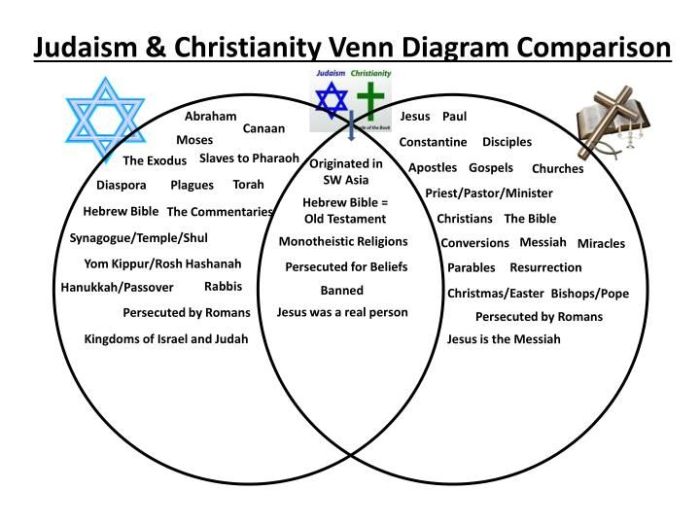The Islam and Christianity Venn diagram serves as a visual representation of the striking similarities and intriguing differences between two of the world’s most influential religions. This comparative analysis delves into their shared historical roots, core beliefs, cultural impact, interfaith dialogue, and artistic expressions, offering a comprehensive understanding of their unique contributions to human civilization.
This exploration unveils the profound impact of Islam and Christianity on art, architecture, literature, and music, shaping the cultural fabric of societies across the globe. It also sheds light on the challenges and opportunities for interfaith cooperation, fostering mutual understanding and respect.
Historical Interconnections

Islam and Christianity share historical roots that trace back to the teachings of Abraham, the patriarch of both religions. The two faiths have influenced each other throughout history, shaping their beliefs and practices.
Early Interactions
- Christianity emerged within the Roman Empire, which had significant interactions with the Arabian Peninsula.
- Arabian traders and merchants came into contact with Christian communities in the Middle East and North Africa.
- These interactions facilitated the exchange of ideas and cultural influences between the two religions.
Influence of Islam on Christianity
- The rise of Islam in the 7th century had a profound impact on Christianity in the Middle East and North Africa.
- Muslim scholars preserved and translated Greek philosophical and scientific works, which were later transmitted to Europe and influenced the development of Western thought.
- Islamic architecture and art influenced Christian architecture and art, particularly in Spain and Portugal.
Beliefs and Practices

Islam and Christianity share core beliefs in monotheism, the existence of prophets, and the importance of moral conduct. However, they differ in specific theological concepts and religious practices.
Similarities
- Both religions believe in one God, who is the creator and sustainer of the universe.
- They recognize the importance of prophets, including Abraham, Moses, and Jesus.
- They emphasize ethical behavior, including compassion, justice, and honesty.
Differences
- Christianity believes in the Trinity (God the Father, God the Son, and God the Holy Spirit), while Islam rejects the concept of the Trinity.
- Islam believes that Muhammad is the final prophet, while Christianity believes that Jesus is the Messiah and the Son of God.
- Christian worship typically involves congregational singing, prayer, and the reading of scripture, while Islamic worship focuses on individual prayer (salat) and communal prayer (jama’ah).
Cultural and Social Impact: Islam And Christianity Venn Diagram
Islam and Christianity have had a significant impact on the cultural and social development of societies around the world. Their teachings and practices have shaped art, architecture, music, and literature.
Influence on Art and Architecture
- Islamic art is known for its intricate geometric patterns and calligraphy, which have influenced the design of mosques, palaces, and other buildings.
- Christian art often depicts biblical scenes and figures, and has inspired countless works of painting, sculpture, and architecture.
- Both Islamic and Christian architecture have influenced the development of Western architectural styles.
Influence on Music and Literature
- Islamic music is characterized by its use of scales, rhythms, and instruments that are unique to the region.
- Christian music has developed a wide range of styles, including hymns, gospel, and contemporary Christian music.
- Both Islamic and Christian literature have produced influential works that have shaped religious thought and cultural identity.
Interfaith Dialogue and Relations

Interfaith dialogue and relations between Islam and Christianity have been marked by both challenges and opportunities for cooperation and understanding.
Challenges, Islam and christianity venn diagram
- Historical tensions and conflicts have created mistrust and prejudice between the two communities.
- Differences in religious beliefs and practices can lead to misunderstandings and divisions.
- Political and social factors can also influence interfaith relations.
Opportunities
- Interfaith dialogue can foster mutual understanding and respect between Muslims and Christians.
- Joint initiatives can address common social and humanitarian concerns.
- Education and outreach programs can promote accurate information and dispel misconceptions.
Misconceptions and Stereotypes

Both Islam and Christianity have faced misconceptions and stereotypes that perpetuate misunderstandings and divisions.
Common Misconceptions about Islam
- That Islam is a violent religion.
- That all Muslims are terrorists.
- That women in Islam are oppressed.
Common Misconceptions about Christianity
- That Christianity is a religion of hate.
- That all Christians are intolerant of other religions.
- That Christianity is only about rules and regulations.
Clarifying Questions
What is the significance of the shared historical roots between Islam and Christianity?
Their common origin in Abrahamic tradition has shaped their beliefs, practices, and cultural expressions, fostering a sense of kinship and mutual respect.
How do the core beliefs of Islam and Christianity differ?
While both religions emphasize monotheism and divine revelation, they diverge in their understanding of the nature of God, the role of Jesus Christ, and the path to salvation.
What are some examples of successful interfaith initiatives between Islam and Christianity?
Initiatives such as the Common Word Movement and the Interfaith Youth Core promote dialogue, understanding, and collaboration, fostering a spirit of cooperation and mutual respect.